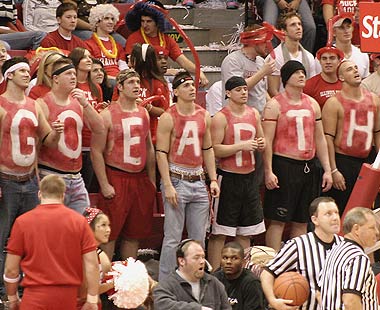 Photo: IscanWhen the 2011 Major League Baseball season got underway last April, teams rolled out the usual promotions for fanatical fans: giant foam fingers, T-shirt giveaways, beer in unbreakable, aluminum bottles. The Seattle Mariners took a slightly different tack. At two separate Monday night home games, 5,000 fans were given bags of gardening soil, composted down from roughly 900,000 pounds of soggy napkins and half-eaten hot dogs collected at the stadium the season before.
Photo: IscanWhen the 2011 Major League Baseball season got underway last April, teams rolled out the usual promotions for fanatical fans: giant foam fingers, T-shirt giveaways, beer in unbreakable, aluminum bottles. The Seattle Mariners took a slightly different tack. At two separate Monday night home games, 5,000 fans were given bags of gardening soil, composted down from roughly 900,000 pounds of soggy napkins and half-eaten hot dogs collected at the stadium the season before.
The Mariners, along with roughly 50 other sports teams in baseball, the NBA, NHL, NFL, NCAA, and several other professional leagues, are members of the Green Sports Alliance, a nonprofit organization formed in March. The alliance was created to encourage sports companies to clean up their acts — and to “use the nonpartisan status of professional sports to advance the environmental message,” said Allen Hershowitz, a senior scientist at the Natural Resources Defense Council, where he founded and now directs the council’s sports-greening initiative.
But for the fan just looking to get his hands on some friggin crackerjacks and a beer — well, who wants a bag of dirt? Is the message getting through? And for all their greening efforts, are sports teams making a dent in the climate problem?
I went to high school on Philadelphia’s Main Line. Even though my home team, the Eagles, led the sports world’s charge toward greening the games in 2003, I had my doubts. Making a stadium more eco-friendly and convincing fans to embrace and spread that message themselves are two entirely different things. I balked at the idea.
To test my theory, I asked my Facebook pals if they cared that sports teams are going green.
“I’d rather them spend money on winning than recycling,” wrote one buddy.
“I don’t go to a game and pay money to go green,” said another. “I do it to enjoy myself and watch my team win.”
“I probably wouldn’t really notice if they ‘went green,'” replied a third. “I would notice if my ticket price went up.”
Alright, so maybe it’s just the company I keep. But what relevant research I could scrape together didn’t help the cause. A 2005 Gallup poll showed that three-quarters of men are sports fans, but in a recent study by OgilvyEarth, 82 percent of responders said they viewed “going green” as girly. Heh. More yards lost for Team Green.
Finally, I took my question to Max Tcheyan at the sports news website Bleacher Report. He said the sight of a composting bin like the ones at Safeco Field probably wouldn’t get him to start composting at home, but it would “cause a sort of disruption in my thinking and hesitation on my part.”
As in: What’s that doing here?
But that may be the ticket. “People do not go to sporting events to get educated about the environment,” Hershowitz admitted. “But when people go to baseball games and they see [the] environment celebrated … they see ribbons going around the stadium saying ‘please recycle’ … what’s happening is, environmental stewardship is being communicated as routine. It doesn’t have to be explicitly shouted at people.”
To the Green Sports Alliance’s credit, its member teams have some measurable progress to report when it comes to cleaning up their venues. The Mariners now recycle or compost 80 percent of their food and beverage waste, says Scott Jenkins, vice president of ballpark operations for the team, and also board chairman of the Green Sports Alliance. “We’ve cut our electrical use by over 30 percent, cut our water use by over 20 percent, cut our natural gas by up to 60 percent depending on the month, and we’ve saved about $1.5 million over a five year period.”
On the national level, Major League Baseball has instituted a Green Track system for measuring energy and water usage, recycling, and paper purchasing among the teams, and the league also awards a Green Glove award to the franchise that recycles the most each year. (The San Francisco Giants have won the title three years running.)
Still, teams in football, basketball, baseball, and hockey continue to pump between 179 and 716 tons of carbon into the atmosphere each game. (Hershowitz notes that 72 percent of all the energy powering arenas in the U.S. comes from fossil fuels, while solar and wind power makes up just 2 percent.) The alliance clearly has a long way to go.
“In an ideal world, every sports facility would be LEED certified … that’s just not in the cards,” says Jenkins. But he maintains that incremental progress toward getting greener is preferable to doing nothing at all.
As for reaching the fans, maybe what we really need are a couple of high-profile players to speak up about the climate. Athletes, especially ones playing for winning teams, are often revered — along with the products or causes they endorse — regardless of whatever else they’ve done. (Remember when Eagles quarterback Michael Vick was electrocuting pit bulls?)
Then again, the fans in the stands spitting their light beer over a bad call by the ref may surprise us. In September, University of Nebraska-Lincoln fans booed an ad for the proposed Keystone XL tar-sands pipeline that appeared in the Cornhuskers’ Memorial Stadium. The university’s athletic director ultimately banned all Keystone advertisements. Last week, President Obama sent federal regulators back to the drawing board with the pipeline, a move that could ultimately kill it.
For now, it seems, it’s too early to throw the red challenge flag on greening the games.



